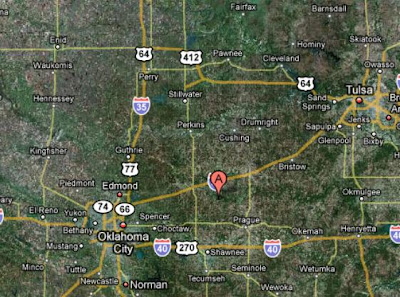
2009 June 14 21:31:08 UTC
Versión en Español
Earthquake Details
| Magnitude | 3.4 |
|---|
| Date-Time | |
|---|
| Location | 35.624°N, 96.854°W |
|---|
| Depth | 5 km (3.1 miles) set by location program |
|---|
| Region | OKLAHOMA |
|---|
| Distances | - 3 km (2 miles) WNW (298°) from Sparks, OK
- 10 km (6 miles) SSE (161°) from Chandler, OK
- 12 km (8 miles) SW (221°) from Davenport, OK
- 64 km (40 miles) ENE (75°) from Oklahoma City, OK
- 314 km (195 miles) N (359°) from Dallas, TX
|
|---|
| Location Uncertainty | horizontal +/- 8.9 km (5.5 miles); depth fixed by location program |
|---|
| Parameters | NST= 10, Nph= 10, Dmin=201.4 km, Rmss=0.68 sec, Gp= 94°,
M-type="Nuttli" surface wave magnitude (mbLg), Version=7 |
|---|
| Source | |
|---|
| Event ID | us2009hwb5 |
|---|
- This event has been reviewed by a seismologist.
- Did you feel it? Report shaking and damage at your location. You can also view a map displaying accumulated data from your report and others.
Earthquake Summary
Felt Reports
mbLg 3.4 (GS).
Tectonic Summary
EARTHQUAKES IN THE STABLE CONTINENTAL REGION
Most of North America east of the Rocky Mountains has infrequent earthquakes. Here and there earthquakes are more numerous, for example in the New Madrid seismic zone centered on southeastern Missouri, in the Charlevoix-Kamouraska seismic zone of eastern Quebec, in New England, in the New York - Philadelphia - Wilmington urban corridor, and elsewhere. However, most of the enormous region from the Rockies to the Atlantic can go years without an earthquake large enough to be felt, and several U.S. states have never reported a damaging earthquake. The earthquakes that do occur strike anywhere at irregular intervals.
Earthquakes east of the Rocky Mountains, although less frequent than in the West, are typically felt over a much broader region. East of the Rockies, an earthquake can be felt over an area as much as ten times larger than a similar magnitude earthquake on the west coast. A magnitude 4.0 eastern U.S. earthquake typically can be felt at many places as far as 100 km (60 mi) from where it occurred, and it infrequently causes damage near its source. A magnitude 5.5 eastern U.S. earthquake usually can be felt as far as 500 km (300 mi) from where it occurred, and sometimes causes damage as far away as 40 km (25 mi).
FAULTS
Earthquakes everywhere occur on faults within bedrock, usually miles deep. Most of the region's bedrock was formed as several generations of mountains rose and were eroded down again over the last billion or so years.
At well-studied plate boundaries like the San Andreas fault system in California, often scientists can determine the name of the specific fault that is responsible for an earthquake. In contrast, east of the Rocky Mountains this is rarely the case. All parts of this vast region are far from the nearest plate boundaries, which, for the U.S., are to the east in the center of the Atlantic Ocean, to the south in the Caribbean Sea, and to the west in California and offshore from Washington and Oregon. The region is laced with known faults but numerous smaller or deeply buried faults remain undetected. Even most of the known faults are poorly located at earthquake depths. Accordingly, few earthquakes east of the Rockies can be linked to named faults. It is difficult to determine if a known fault is still active and could slip and cause an earthquake. In most areas east of the Rockies, the best guide to earthquake hazards is the earthquakes themselves.
Earthquake Information for Oklahoma
Scientific & Technical Information

